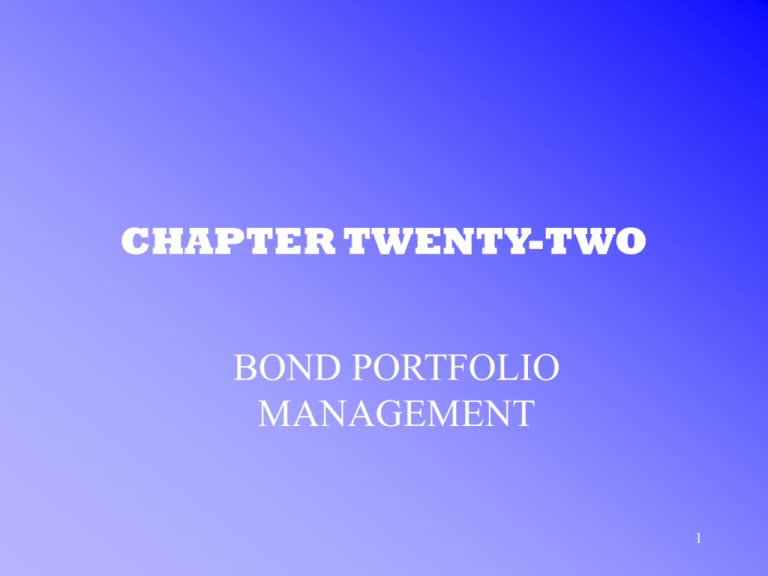Document
advertisement

CHAPTER TWENTY-TWO BOND PORTFOLIO MANAGEMENT 1 BOND PORTOLIOS • METHODS OF MANAGEMENT – Passive • rests on the belief that bond markets are semi-strong efficient • current bond prices viewed as accurately reflecting all publicly available information 2 BOND PORTOLIOS • METHODS OF MANAGEMENT – Active • rests on the belief that the market is not so efficient • some investors have the opportunity to earn aboveaverage returns 3 BOND PRICING THEOREMS • 5 BOND PRICING THEOREMS – for a typical bond making periodic coupon payments and a terminal principal payment 4 BOND PRICING THEOREMS • 5 BOND PRICING THEOREMS – THEOREM 1 • • • • If a bond’s market price increases then its yield must decrease conversely if a bond’s market price decreases then its yield must increase 5 BOND PRICING THEOREMS • 5 BOND PRICING THEOREMS – THEOREM 2 • If a bond’s yield doesn’t change over its life, • then the size of the discount or premium will decrease as its life shortens 6 BOND PRICING THEOREMS • 5 BOND PRICING THEOREMS – THEOREM 3 • If a bond’s yield does not change over its life • then the size of its discount or premium will decrease • at an increasing rate as its life shortens 7 BOND PRICING THEOREMS • 5 BOND PRICING THEOREMS – THEOREM 4 • A decrease in a bond’s yield will raise the bond’s price by an amount that is greater in size than the corresponding fall in the bond’s price that would occur if there were an equal-sized increase in the bond’s yield • the price-yield relationship is convex 8 BOND PRICING THEOREMS • 5 BOND PRICING THEOREMS – THEOREM 5 • the percentage change in a bond’s price owing to a change in its yield will be smaller if the coupon rate is higher 9 CONVEXITY CONVEXITY DEFINITION: – a measure of the curvedness of the price-yield relationship 10 CONVEXITY • THE PRICE-YIELD RELATIONSHIP Price YTM 11 CONVEXITY • THEOREM 1 TELLS US – price and yield are inversely related but not in a linear fashion (see graph) – an increase in yield is associated with a drop in bond price – but the size of the change in price when yield rises is greater than the size of the price change when yield falls 12 DURATION • DEFINITION: – measures the “average maturity” of a stream of bond payments – it is the weighted average time to full recovery of the principal and interest payments 13 DURATION • FORMULA PV (Ct ) D P0 t 1 T t where P0 = the current market price of the bond PV(Ct )= the present value of the coupon payments t = time periods 14 DURATION • THE RELATION OF DURATION TO PRICE CHANGES – THEOREM 5 implies • bonds with same maturity date but different coupon rates may react differently to changes in the interest rate • duration is a price-risk indicator 15 DURATION • DURATION IS A PRICE-RISK INDICATOR – FORMULA p D(1 ytm) p rewritten y p D 1 y p where y = the bond’s yield to maturity 16 DURATION • MODIFIED DURATION D – FORMULA: Dm 1 y – reflects the bond’s % price change for a one percent change in the yield 17 DURATION • THE RELATIONSHIP BETWEEN CONVEXITY AND DURATION – whereas duration would have us believe that the relationship between yield and price change is linear – convexity shows us otherwise 18 DURATION • THE RELATIONSHIP BETWEEN CONVEXITY AND DURATION P C 0 YTM 19 IMMUNIZATION • DEFINITION: a bond portfolio management technique which allows the manager to be relatively certain of a given promised cash stream 20 IMMUNIZATION • HOW TO ACCOMPLISH IMMUNIZATION – Duration of a portfolio of bonds • equals the weighted average of the individual bond durations in the portfolio – Immunization • calculate the duration of the promised outflows • invest in a portfolio of bonds with identical durations 21 IMMUNIZATION • PROBLEMS WITH IMMUNIZATION – default and call risk ignored – multiple nonparallel shifts in a nonhorizontal yield curve – costly rebalancing ignored – choosing from a wide range of candidate bond portfolios is not very easy 22 ACTIVE MANAGEMENT • TYPES OF ACTIVE MANAGEMENT – Horizon Analysis • simple holding period selected for analysis • possible yield structures at the end of period are considered • sensitivities to changes in key assumptions are estimated 23 ACTIVE MANAGEMENT • TYPES OF ACTIVE MANAGEMENT – Bond Swapping • exchanging bonds to take advantage of superior ability to predict yields • Categories: – – – – substitution swap intermarket spread swap rate anticipation swap pure yield pickup swap 24 ACTIVE MANAGEMENT • TYPES OF ACTIVE MANAGEMENT – Contingent Immunization • portfolio managed actively as long as favorable results are obtained • if unfavorable, then immunize the portfolio 25 PASSIVE MANAGEMENT • TYPES OF PASSIVE MANAGEMENT – INDEXATION • the portfolio is formed to track a chosen index 26






